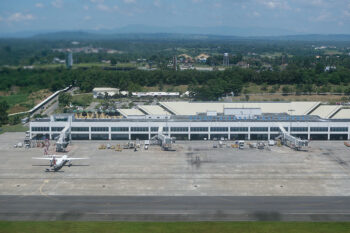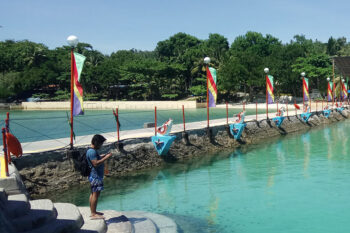II. Facing Realities
GENERAL SANTOS CITY (MindaNews/10 August)– How the FAB got stuck in the roadmap is water under the bridge. So are the questions: Could the peace process have turned out differently had the MILF position prevailed instead of Leonen’s “honestly different” approach? Could the peace process not have stuck in the FAB roadmap?
II. Facing Realities
These questions have become moot but they vividly show what Government really wants. Behind the rhetoric to avoid the mistakes of Arroyo in resolving the Bangsamoro Problem within his six-year term, Aquino’s view of the Bangsamoro Problem, honestly, is not different from Arroyo’s. Metaphorically, Aquino only changed the door, not the room; the solution, not the answer. The change could not make the room and answer acceptable to MILF.
What realities float in the water past the bridge?
Honestly, Not Different
After the MOA-AD had been aborted, the Arroyo government offered in “GRP Draft Proposal” the ARMM as “Enhanced Autonomy” or “The Highest Form of Autonomy for Muslim Mindanao”. It adopted some consensuses in the MOA-AD. To be enhanced by eight executive doables and an amended Organic Act, ARMM would be handed to MILF before Arroyo’s term ended on June 30, 2010.
The MILF panel skipped the second day of the 17th exploratory talk and on the following day, January 28, 2010, Iqbal explained to the Facilitator and the International Contact Group that they saw no point in attending that session since “… the GRP draft has not conformed to the basic agreed principles in the Joint Statement for the resumption of negotiation dated 29 July 2009” – the topic which GRP outlined in December 2009.
To this explanation, GRP Panel Chair Rafael Seguis replied through GMANews.TV on the following day: “Di inaasahan na magkatugma ang draft ng dalawa. Iba ang demand nila, iba ang aming pag-iisip kung ano ang content ng peace agreement. (The GRP and MILF drafts are not expected to be the same. They have different demands; we have different ideas on what the peace agreement should contain.)”
After seven months of studying the MILF Draft Agreement 2011 – Iqbal had similarly observed — GPH culled provisions that agreed with the government position and welded these into the “GPH ‘3 for 1’ Proposal”. MILF rejected it citing “heaven and earth” gap between the two drafts.
Of the “gap”, Leonen said: “It depends on who is looking at this gap and on what prism or what filter to use. Of course, from our perspective we think it is very workable. … In other words, it is not too far apart. Of course from the statement made by the MILF, it appears to be a very wide chasm.” He directly addressed the MILF: “[I]n negotiations, it should be expected that the other party opens with ideas different from yours.”
Leonen’s rhetorical and Seguis’ blunt responses, though nineteen months apart, were basically the same underscoring the same reality: Government sees the Moro Problem differently from MILF viewpoints; it will grant the autonomy it thinks fit and proper. This the contrary assessments by the Parties of the GPH draft further elucidated.
GPH “3 for 1” Proposal
As discussed earlier, MILF rejected outright the GPH draft. Iqbal explained: The draft (1) is way below the MILF expectation; (2) has no meeting point with the MILF draft; (3) is not solving the Moro Question but prolonging it; (4) is maintaining, reenergizing and re-entrenching the government domination over the Moros; and (5) has derogated from all signed agreements and documents. After this, except when media solicited more explanation of its “heaven and earth” objection, MILF held its ground in silence.
To sell it to the public even if MILF had rejected it, Government spiritedly defended and advocated the “3 for 1” peace draft in media statements and conferences with civic organizations, business leaders and bishops as the real solution to the Moro Problem which is rooted in poverty, lack of education and other socioeconomic factors. To the MILF objections, Government countered: GPH “3 for 1” Proposal is principled, realistic and practical.
1. Founded on partnership, it will “achieve a comprehensive, just and lasting peace”; it will “create … meaningful and effective governance”; it “will bring in the … social services and projects” for “sustainable economic development”.
2. Politically comprehensive, it will reform “the relationship between the national and the regional governments”; it will find ways to unite the leaders of “the Bangsamoro, the Christian settlers and indigenous peoples in the conflict affected areas” in “finding convergence of programs” – understood to be for socioeconomic development.
3. Working with “what is available and doable within the next few years”, it will meet “the urgent and present needs of many communities”. Alluding to MILF demands for political settlement, it “does not start with contentious and divisive issues whose resolution may not be realistic as yet”.
4. It will entrench the form of government that “should be able to deliver good and effective governance, social services and foster economic development within the soonest possible time”.
5. As a political document, it is aware “of the extent of the legal and political powers of the President” and it is defensible in “public discussions [and] debates” and “in other constitutional forums such as the legislature and the courts”.
6. On the issue of the ARMM as a “failed autonomy”, it delves into the causes and proposes to reform the ARMM into “a more empowered, more workable, and thus, more genuine autonomy of Bangsamoro region”. [Note: This is very significant in relation to the FAB.]
7. It addresses concerns in “the identity of Bangsamoro and its history”; in “revenue and the use of resources” in enhancing autonomy” and in ensuring their sustainability: and in “the process of normalization”.
The Proposal is really an invitation for MILF to be a partner in the socioeconomic reform of the ARMM as the autonomy Government wants. Contrary to political settlement MILF is demanding, socioeconomic development is the solution to the Bangsamoro Problem.
More from the Leaders
The gap is really wide, even not as wide as the hyperbolic “heaven and earth”. To be candid about the Moro Problem, most see the government position, hence the Proposal, as the viable and the immediate solution – not just among non-Moros but even among Moros. Significantly, the MILF say they are not against economic development; but political settlement must come first. The government panel stood squarely behind the Proposal; yet, they reached out to the MILF panel to close the gap.
Professor Miriam Coronel-Ferrer, then GPH panel member and now chair, in her commentary (Philippine Daily Inquirer, August 29, 2011: A Comprehensive package for autonomy), summed up the Proposal stressing the autonomy Government wants:
First: “In all, the GPH panel is saying that most of the demands of the MILF for self-governance can be accommodated within the present Constitution.” If “many of the features envisioned by the MILF” are incorporated in “passing a new Organic Act”, the ARMM will become “a more functional, representative and participatory governance institution”.
Second: “The GPH offer is, therefore, principled and pragmatic. It is transformational rather than ‘surgical’. While it understands the vision behind the MILF’s proposal for constitutional amendments that will allow the creation of a Bangsamoro substate whereby they themselves will craft the Bangsamoro Basic Law, the GPH is saying that this option is not viable at this time.” (Bold supplied)
Leonen frankly reached out to the MILF panel on two occasions in Cotabato City:
At a conference in Estosan Hotel on August 30, he said: “We understand the MILF may not agree with the approaches of government but we entreat them and urge them for the sake of peoples in Mindanao to not simply posture by rejecting our proposal but to sit down with us and continue to dialogue and converse and see the extent of our differences but also more importantly the extent of our agreements.” (MindaNews, August 31, 2011: GPH to MILF: “let’s sit down, discuss differences and agreements)
At a forum on the next day, speaking in mixed Tagalog-English, he made public what could be the content of a letter he said he had sent to Iqbal: The GPH draft “is our minimum opening position. All in it are okay with us. If you want to revise the draft, let’s talk it over. You tell us why our approach is wrong. Let’s discuss how to resolve the differences. If you like we can change the entire draft.” (MindaNews, September 3, 2011: GPH to MILF: proposal to MILF is “minimum;” entire draft can be changed)
He reminded the MILF leaders that among the formidable obstacles to their demands are the Congress and many others. How to convince them of the need to amend the 1987 Constitution to accommodate the MILF demand for political settlement is most difficult. He was suggesting MILF should reconsider their demands.
Unmoved, Chairman Murad said the Congress and others should not fear MILF. He virtually asked Leonen to tell them to see the truth about the MILF and their demands — a challenge to Government to dispel the misconceptions about MILF and the Moros.
Closing the Gap
The “heaven and earth” gap created by the GPH “3 for 1” Proposal boldly stated two realities: Government proclaimed, “This is the autonomy for the Moros we want.” MILF was forthright: “We reject that autonomy.” That is now water under the bridge.
The closing of the gap debunked Leonen’s “honestly different” negotiation mode. From extremely far apart positions, Government and MILF met midway to seal the Decision Points on Principle and the Framework Agreement on Bangsamoro. This, too, is seen in the negotiation of the Annexes.
With this closing of the gap, how close is the realization of the Bangsamoro as the political settlement envisioned by MILF to solve the Bangsamoro Problem? (To Be Continued) (“Comment” is Mr. Patricio P. Diaz’ column for MindaViews, the opinion section of MindaNews. The Titus Brandsma Media Awards honored Mr. Diaz with a “Lifetime Achievement Award” for his “commitment to education and public information to Mindanawons as Journalist, Educator and Peace Advocate.” You can reach him at patpdiazgsc@yahoo.com.)







